

Introduced: 1979 (discontinued circa 1999 when Minitrix was bought out by Marklin)
The locomotive and tender shells for this 2-10-0 were originally created for Minitrix's 4-6-2 K4 Pacific in 1970. The design work for said shells was provided by one Ted Brandon (an American serviceman and ardent model railroader stationed in Germany at that time). The story continues in 1979 when Minitrix decided to create a new North American steamer (this time a Decapod) by mounting Ted's old K4 shell on one of their European 2-10-0 mechanisms (and with the K4 tender thrown in as well). Unfortunately, this created a bit of a Frankenstein's monster that few could love (at least in terms of its looks). There are many problems here, but the main "oops" is the fact that the smokestack and steam pipes don't line up with the cylinders (hey, Steam 101). Still, it was/is a respectable performer and remains popular amongsy Pennsy modelers.
The chassis, although all metal, is fairly minimalistic. Consequently, a couple of free-floating weights have been thrown in for additional heft (one inside the cab and one over the forward drivers) -
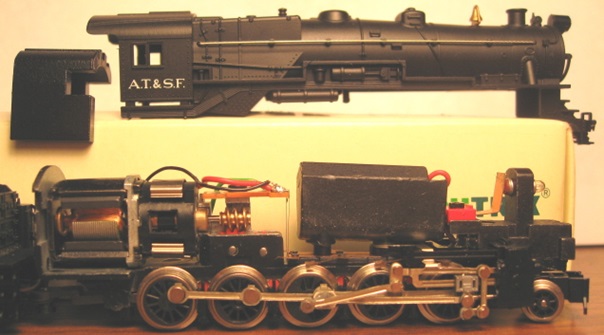
The motor is an open-sided 3-poler. Apart from the plastic idler gear, all of the gearing is brass. All ten drivers are geared. The forward six drivers provide pickup (with the rear four drivers being equipped with traction tires). The pilot truck picks up left-rail current only. A non-directional headlight is mounted to the front of the chassis. The pilot has a non-functional knuckle coupler. The locomotive/tender drawbar connection is held in place with a screw. Oversized wheel flanges render this loco useless on anything like Code-55 track.
Each truck on the tender picks up current from one rail. As pictured below, current was originally transferred from the tender to the engine by way of the drawbar (from one truck) and an insulated wire (from the other truck). Later versions eliminated the somewhat iffy drawbar connection from the equation and used two wires instead. Unfortunately, the tender trucks collect current via axle wipers (a notoriously unreliable scheme). There is a reverse light housing on the tender shell, although it is non-functional (IE, no bulb). The tender coupler is a truck-mounted Rapido -
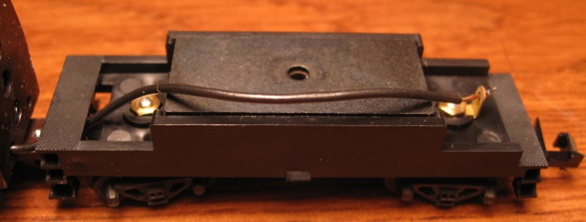
This is supposedly the cream of the North American Minitrix steamers. And although I'll grant that it does run better than all the rest of them, it is not without its issues. Due to the relatively primitive tender pickup design, occasional hesitation and stalls are a problem. And although it runs relatively quietly, it does have a bit of a "metal gears" growl to it. The oversized flanges make navigating through turnouts a bit of an adventure, and the motor doesn't seem to allow for much subtlety at the slow speed end of the throttle. So, although a decent enough running steamer by 1970s standards, 21st century modelers may find it a bit wanting.
A popular solution to the tender (axle wiper) pickup problem is to install Kato (or Bachmann) trucks. This will go a long way towards improving performance. Also, I'm told that slow-speed performance can be greatly improved by swapping out the stock 3-pole motor for a 5-pole Kato GM-5 motor. Vis -
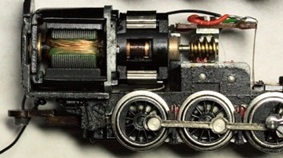
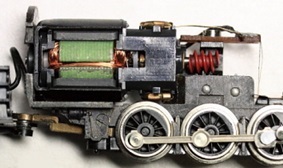
(Original 3-pole motor on the left, Kato 5-pole motor on the right)
Back in the day (I'm assuming 1980's), Camden & Amboy actually sold a cast resin shell kit that supposedly fixed all the problems. Unfortunately, I imagine these kits are quite difficult to find nowadays -

One homebrew solution to the "misaligned steam pipe" problem (as supplied by my buddy Alex Gillam) is to chop off the front of the chassis, shorten the pilot truck, and then simply slide the shell backwards -
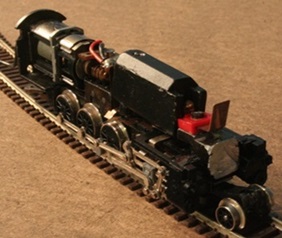
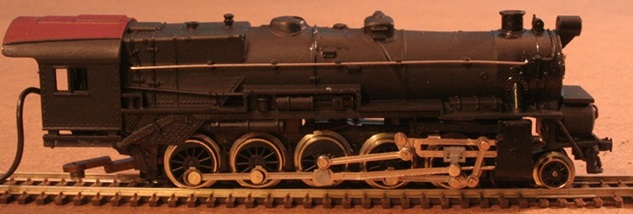

To remove the locomotive shell, simply unscrew the screw on top and it will lift right off. To remove the tender shell, simply spread the sides apart and lift it off.
Grade: C (mainly for the shell issues, although right around a B for performance)
Reviewed: 9/79 Model Railroader ("The Minitrix model, imported from West Germany by Model Power, is not an exact replica of the Pennsylvania I1. It combines the tender and superstructure from the firm's PRR K4 Pacific with a German prototype 2-10-0 mechanism. Some I1s did have this type of tender, and while the K4 boiler is too small for the Decapod, it does have the heavy-duty Pennsy look. The mechanism is where the model's appearance suffers most, for its cylinders don't line up with the smokestack and steam pipes, and it lacks the I1's characteristic pilot-mounted double air tanks... The mechanism does perform well. It is powered by an open-frame, three-pole motor... As with most N scale steamers, power is transmitted to the other driving axles through idler gears enclosed in the metal frame. The model's slow speed performance is good and control is good throughout the range, but the top speed is entirely too fast for this type of engine. Four rubber traction tires contribute to the excellent draw-bar pull, which should equal about 35 N scale freight cars. The model has weights in its boiler and cab and there is little room to add more. A system of wipers is arranged to pick up current from three wheels on each side of the engine and two wheels on each side of the tender, so the model should enjoy good contact on the layout... While it has its faults, this is a good-looking, smooth-running locomotive. Since steam engine selection in N scale is limited, the Minitrix 2-10-0 could be the basis for modeling other ten-coupled types. PRR, SF, CN, CP. Price: $57.50")